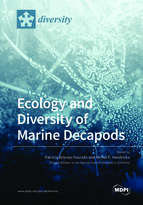Ecology and Diversity of Marine Decapods
A special issue of Diversity (ISSN 1424-2818). This special issue belongs to the section "Marine Diversity".
Deadline for manuscript submissions: closed (15 February 2022) | Viewed by 42141
Special Issue Editors
Interests: ecology of crustaceans, especially of Caribbean ecosystems; decapods; benthic ecology; community composition; behavioral ecology; feeding ecology; reproductive ecology, population dynamics
Interests: ecology, taxonomy and zoogeography of marine invertebrates, particularly crustaceans and molluscs; bathymetric distribution, zoogeography and trophic aspects of pelagic and benthic stomatopods and decapods of the Pacific
Special Issue Information
Dear Colleagues,
Decapods (shrimps, crayfish, lobsters, hermit crabs, and crabs) are one of the most diverse crustacean orders with around 12,000 described species, most of which are marine. Many decapods sustain important fisheries, but their diversity and the ecological roles they play are far from being well understood. Although some marine decapods are pelagic, most species occur in shallow and deep benthic ecosystems, including coral reefs, seagrass meadows, macroalgal beds, kelp forests, rocky coasts, and hydrothermal vents, where they have important regulatory functions. Decapods encompass herbivores, detritivores, carnivores, and omnivores, and are in turn consumed by many higher-order consumers, thus constituting a critical link in many food webs. Decapods have complex behaviours and are involved in symbiotic relationships with members of many other phyla. In many marine decapods, population connectivity depends on pelagic larvae that develop as part of the meroplankton for weeks or even months, thus also playing a significant role in planktonic ecology. Throughout the world, decapod populations are threatened by climate change, habitat degradation and loss, invasive species, changes in abundance of their predators, overfishing, and diseases.
For this Special Issue, we invite submissions that address all aspects of research on marine decapod diversity and ecology, such as species diversity, community composition, distribution and ecological functions, population dynamics and connectivity, feeding ecology and trophic interactions, larval ecology, behavioural ecology, disease ecology, and symbiotic relationships with other species. We welcome studies in pelagic and/or benthic decapods from any type of marine environments, and from the local to the global scale.
Dr. Patricia Briones-Fourzán
Dr. Michel E. Hendrickx
Guest Editors
Manuscript Submission Information
Manuscripts should be submitted online at www.mdpi.com by registering and logging in to this website. Once you are registered, click here to go to the submission form. Manuscripts can be submitted until the deadline. All submissions that pass pre-check are peer-reviewed. Accepted papers will be published continuously in the journal (as soon as accepted) and will be listed together on the special issue website. Research articles, review articles as well as short communications are invited. For planned papers, a title and short abstract (about 100 words) can be sent to the Editorial Office for announcement on this website.
Submitted manuscripts should not have been published previously, nor be under consideration for publication elsewhere (except conference proceedings papers). All manuscripts are thoroughly refereed through a single-blind peer-review process. A guide for authors and other relevant information for submission of manuscripts is available on the Instructions for Authors page. Diversity is an international peer-reviewed open access monthly journal published by MDPI.
Please visit the Instructions for Authors page before submitting a manuscript. The Article Processing Charge (APC) for publication in this open access journal is 2600 CHF (Swiss Francs). Submitted papers should be well formatted and use good English. Authors may use MDPI's English editing service prior to publication or during author revisions.
Keywords
- Marine decapods
- Species diversity
- Community composition and ecology
- Behavioral ecology
- Biodiversity and conservation
- Connectivity
- Decapod symbioses
- Decapod larval ecology
- Disease ecology
- Feeding ecology and trophic interactions







